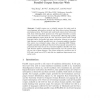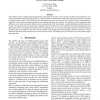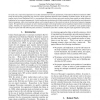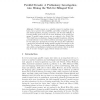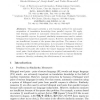NAACL
2004
15 years 1 months ago
2004
We propose a theory that gives formal semantics to word-level alignments defined over parallel corpora. We use our theory to introduce a linear algorithm that can be used to deriv...
99
Voted
EACL
2003
ACL Anthology
15 years 1 months ago
2003
ACL Anthology
Compounded words are a challenge for NLP applications such as machine translation (MT). We introduce methods to learn splitting rules from monolingual and parallel corpora. We eva...
90
Voted
ECIR
2006
Springer
15 years 1 months ago
2006
Springer
Parallel corpora are a valuable resource for tasks such as cross-language information retrieval and data-driven natural language processing systems. Previously only small scale cor...
LREC
2008
15 years 1 months ago
2008
The number and sizes of parallel corpora keep growing, which makes it necessary to have automatic methods of processing them: combining, checking and improving corpora quality, et...
88
Voted
LREC
2010
15 years 1 months ago
2010
Parallel corpora are indispensable resources for a variety of multilingual natural language processing tasks. This paper presents a technique for fully automatic construction of c...
89
Voted
LREC
2010
15 years 1 months ago
2010
In recent years, corpus based approaches to machine translation have become predominant, with Statistical Machine Translation (SMT) being the most actively progressing area. Succe...
ACL
2007
15 years 1 months ago
2007
We present the design and evaluation of a translator’s amenuensis that uses comparable corpora to propose and rank nonliteral solutions to the translation of expressions from th...
AMTA
1998
Springer
15 years 4 months ago
1998
Springer
Abstract. Parallel corpora are a valuable resource for machine translation, but at present their availability and utility is limited by genreand domain-speci city, licensing restri...
116
Voted
KES
2005
Springer
15 years 6 months ago
2005
Springer
This paper presents a new learning method for automatic acquisition of translation knowledge from parallel corpora. We apply this learning method to automatic extraction of bilingu...
130
Voted
TSD
2007
Springer
15 years 6 months ago
2007
Springer
The world wide web is a natural setting for cross-lingual information retrieval. The European Union is a typical example of a multilingual scenario, where multiple users have to de...

